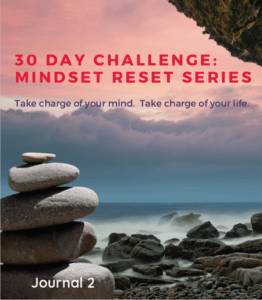
September 17, 2018 30 Day Mindset Reset Challenge- Part 2 – Ability and Accomplishment
Are you willing to start writing a book and have the first draft be ignored?
Are you willing to start painting and have a collection of canvases that show progression, not perfection?
Are you willing to make a mistake or encounter something you’ve never encountered before and believe you can work your way through it- one way or another?
Are you ok with failing at something, knowing that it will actually take you to the next level?
Failure is like that teacher you had in school that was hard on you…kind of a jerk…but taught you so much more than standard curriculum. At the time, you can’t stand them. Then, sometimes years later, you deeply appreciate what you learned from them.
There’s a lot of fear about failure in our culture and we talked about that in Part 1 of this 30 day challenge. Most of us grew up in a system where failure is not tolerated on any level. If you don’t break out of the gate full tilt on path to being number 1, you’re labeled as someone who should probably run a different race.
What a bunch of crap.
Chapter 3 of “Mindset” is SO important in beginning to shatter fixed mindset thought patterns like that.
Carol writes, “There are many myths about ability and achievement, especially about the lone, brilliant person suddenly producing amazing things.” (page 56, “Mindset”)
She goes on write about several famous people who always seemed to have super-human abilities, acting pretty much on their own. But that’s all b.s.- Most of them had a long series of colossal failures and a big team and even funding to help them continue their work despite those setbacks.
For most of us, we feel we can’t do something great because we’ve never been shown a realistic path to success. We just see the result. We don’t relate to the person posing for the publicity photos because we don’t see failure or growth or where they were on Day 1. We certainly don’t see ourselves.
You can’t be what you can’t see.
This is especially true for women and minorities. This chapter touches on those issues and they’re so critical to address. Not necessarily something to dwell on, but something to recognize and call out so that you can shut down the stereotype’s ability to hinder your progress.
When you challenge yourself, all those old voices, words and beliefs start screaming in protest. When you know they’re invalid, it’s easier to press on.
Before going into the horrible dangers of stereotyping, though, Carol starts off with talking about ‘gifted’ kids. I love the analogy she uses about extremely gifted children. She points out that it’s not really the ‘gift’ itself that takes the child to such heights, it’s the endless curiosity and challenge seeking around the gift that makes their talent remarkable. These children may be born with a special ability, but their extreme love of learning around this ability (it’s usually insatiable) is what grows their ability rapidly and powerfully.
Seeing a ‘gifted’ person in action may leave us feeling a bit hopeless…like we could never achieve their success because we weren’t BORN with their ability.
Know what I love about having a growth mindset? Some of our abilities may start small, but there’s not much of a limit on how much they can grow.
“Prodigies or not, we all have interests that can blossom into abilities.” (page 63, “Mindset”)
Page 68 is one of my favorite parts of this book.
Carol writes about her apparent lack of artistic ability- that her drawing skills never progressed much past elementary school. She decided to read a book called “Drawing on the Right Side of the Brain” by Betty Edwards and it deeply impacted her. Edwards agrees that most people view drawing as a magical ability, that only a select few possess, but this is because people don’t understand the LEARNABLE components of drawing. Actually, she informs her readers, that they are not drawing skills, but seeing skills.
It’s the ability to perceive edges, spaces, relationships, lights and shadows and the whole. Learn each component skill and then combine them to create your drawing.
The before and after sketches with just 5 days of learning the basics had incredible results…it didn’t look like the same person that did the sketch on Day 1 was the one who created a portrait on Day 5.
Here’s what this means: Just because some people can do something with little or no training, doesn’t mean that others can’t do it (and sometimes do it even better) with training.
Her story about Jackson Pollack sums this up nicely.
It turns out that he wasn’t born with an elevated ability to paint. In fact, his early work wasn’t very good, but he dreamed of being an artist and pursued it with all his heart. He saw himself as being an artist and got down to learning everything he could about various painting techniques. Once he got those techniques down (after years of working at it!) he started to create original art that was stunning and completely different from what anyone else had seen before.
The Danger of Praise and Positive Labels
Tying in with the section about gifted kids, Carol writes about positive labeling and how a simple label can create a domino effect of fear and failure…even lying…even when the label is supposed to be kind and encouraging. For many people, she goes on to write, the positive label wound up hindering success and enjoyment because the moment someone ‘fails’ at something or suddenly has to put a lot of effort into learning taking that skill to the next level, they feel their label is being stripped away.
Did her findings about positive labels in this part of the book surprise you? They certainly surprised me!
What brought it home for me was the letter a reader of hers wrote to her on page 74:
Dear Dr Dweck,
It was painful to read your chapter…as I recognized myself therein.
As a child I was a member of The Gifted Child Society and continually praised for my intelligence. Now, after a lifetime of not living up to my potential (I’m 49), I’m learning to apply myself to a task. And also to see failure not as a sign of stupidity but as a lack of experience and skill. Your chapter helped me see myself in a new light.”
Negative Labels and How They Work
Prejudism and sexism- has it held you back? Did you suddenly lose interest in something based on crappy stereotypes you’ve been labeled with?
What was upsetting in this part of the book is learning that you probably have been impacted more times you can count without fully realizing it. Yuck! Carol writes about research done by Claude Steele and Joshua Aronson showing that just ticking a box to indicate your sex or race can trigger a stereotype in your mind and lower your test score- a lot.
This mainly happens to people with a fixed mindset. She continues that people’s minds can be filled with all those ugly voices telling them who they are or what they can’t do…so much so that they don’t have enough mental power to ignore it. They resonate with the ugly message.
“In a fixed mindset, both positive and negative labels can mess with your mind. When given a positive label, you’re afraid of losing it, and when you’re hit with a negative label, you’re afraid of deserving it…
When people are in a growth mindset, the stereotype doesn’t affect their performance. The growth mindset takes the teeth out of the stereotype and makes people better able to fight back…
They don’t believe in permanent inferiority.
And if they are behind, – well then they’ll work harder, seek help, and try to catch up.”(pg 75-76, “Mindset”)
Carol writes that “a growth mindset helps people see prejudice for what it is- someone else’s view of them- and to confront it with their confidence and abilities intact.” (page 78 “Mindset”)
There is so much power in being able to separate yourself from other people’s opinions. It doesn’t mean it doesn’t hurt. It doesn’t mean it isn’t unfair. It simply means that when we can do that, we can be better problem solvers and creative thinkers with an ability create a new reality for ourselves.
She closed out her 3rd chapter writing about trusting people’s general opinions.
I think almost everyone suffers from this to some degree, but I agree that women seem to really struggle with it.
She points out that women in the US often use other’s opinions as a way to gauge their abilities where as men take other’s opinions much less seriously.
Do people’s off-hand remarks really throw off your day or does that stuff roll right off your shoulder?
There’s no right or wrong answer here, but next time someone’s comments derail your day, ask yourself if their opinion really matters to begin with. Dig into it a little bit…what kind of power are you giving others over your life and how you feel about yourself?
Download your new free journal printable to explore these questions further! These pages can be added to the journal printable from last week.




Sorry, the comment form is closed at this time.